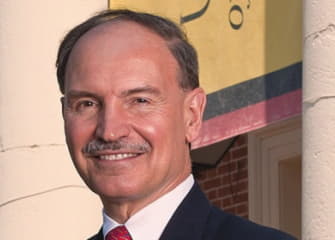
Bob Chrencik
Click here for Part I & Part II
Bob Chrencik, President and CEO of the University of Maryland Medical System, highlights the growth of UMMS as a university-centered medical system since its founding in 1984. “We are all about serving patients across the state of Maryland every day,” Chrencik says. Today, UMMS not only includes hospitals and regional health systems, but a full spectrum of health related services. Earlier this month, UMMS affiliated with Dimensions Healthcare System (DHS), which will now be known as University of Maryland Capital Region Health, serving residents of Prince George’s County and Southern Maryland. UMMS works in close partnership with the University of Maryland School of Medicine, chartered in 1807 as the first public medical school in the United States. UMMS operates its flagship academic hospital, the University of Maryland Medical Center in Baltimore which is also home to the world-renowned R Adams Cowley Shock Trauma Center and the nationally-recognized Greenebaum Comprehensive Cancer Center. Other UMMS member hospitals serve urban, suburban, and rural communities across the State. UMMS has also evolved to include University of Maryland Medical System Health Plans, a wholly-owned company offering insurance programs for Medicare and Medicaid beneficiaries, and the University of Maryland Quality Care Network, a provider-organized network of physicians and other health care providers in the state, and other health care providers in the state. Mr. Chrencik discusses how UMMS, with 25,000 employees and revenue of $4 billion annually, is well-positioned in the complex and highly competitive Maryland health care marketplace and how the environment is changing from in-patient focused health care delivery to managing the health of patient populations.

EDWIN WARFIELD: Can you tell us about some of the institutions in the system?
BOB CHRENCIK: Saint Agnes Hospital, of course, is just a few miles west of our University of Maryland Medical Center in the West Baltimore area. What happened in this State in 2014 was, with the Affordable Care Act, it became a major new focus on not just providing great healthcare but managing the health of populations. There’s a term that is used frequently called “population health”: not just being concerned with cranking up more admissions and surgeries, but actually managing the health of a population, particularly those with chronic diseases.
If you look at West Baltimore—and sadly, the same is true in East Baltimore—some of sickest zip codes in the United States are in West Baltimore, in terms of the number of admissions per thousand residents. What it says is chronic disease, heart disease, and other diseases are very prevalent there, but we share that piece of geography with Saint Agnes. Saint Agnes is a very capable hospital. Many of those physicians are University of Maryland Medical School graduates or resident trainees. We know the Saint Agnes folks very, very well. We came together with them and we said, “Listen, let’s work together in West Baltimore to elevate the health status of that population,” and then we said, “But, you know, we should also be sharing other resources. We should be sharing the medical expertise of the medical center and trying to come together wherever we can.”
Saint Agnes Hospital is owned by the largest catholic healthcare system in the United States. It’s called Ascension Health, out of St. Louis. Saint Agnes is the only hospital that they own here in Maryland, which is a very complex and highly competitive market, so they felt partnering with a large system like ours would allow them to competitively be stronger, but also share resources—but most importantly, we would come together, and we have in a pretty successful way, to really improve the health status of West Baltimore residents as they move around in the healthcare delivery system. It’s has been a great thing. It’s a clinical partnership and it’s expanding, so it’s great stuff.
Q. How have shifts in healthcare law, technology, and demand changed how you operate?
A. What’s happening out across the healthcare system is organizations like ours, which were focused exclusively on health care delivery, more and more are being asked not just to deliver great healthcare but to manage the health of populations. We looked at that and said, “you know, if that’s where the world is going”—and the Maryland Rate Setting System is clearly taking us there with this new, what we call “Medicare waiver” that came out of the Affordable Care Act. We’re being asked to keep people out of the hospital, to invest in their health, avoid re-admissions, do the things that get the patient to the lowest cost setting, which is really managing care. We said, “if we’re going to manage care then we ought to move up what we call ‘the premium food chain’ towards a higher part of it and actually accept risk: take the premium and accept the risk that goes with it to manage that care.”
It wasn’t our core competence. We’re healthcare delivery people; we’re hospital people, doctors, those kinds of things—we’re not insurers. So we said, “we need to go out and find that expertise.” We found that here in a locally managed and run health insurance organization called Riverside Health. They had a Medicaid managed care organization—now it’s close to 40,000 Medicaid lives. This became a “build or buy” decision for us: we could try to build that capability—it’s not our core competence—or we could try to acquire it, and we decided it was better and faster and gave us a better chance for success to acquire it. We knew the CEO, a very capable guy called Mark Puente, and so we went to Mark and said, “How about joining our organization?” And we have very successfully brought Riverside into the University of Maryland Medical System.
Since then, we’ve added a Medicare product called the Medicare Advantage Product, which is a managed care product in the Medicare space. We have a Medicaid space and we have a Medicare space, and we’ve also created something called a quality care network of physicians. We now have about 250 community physicians in a network where we’re now reaching out to some of the commercial carriers about managing risk and taking responsibility for the care of their patients. It’s a new venture but so far so good.
Connect with Bob on LinkedIn
Sponsored by:
Founded in 1993, WMS Partners is the only independent multi-family office in the Baltimore area that isn’t associated with a brokerage firm, bank or trust company. Our team of approximately 50 professionals and 14 owners spanning three generations assists in the direction of our client’s financial goals and objectives and oversees in excess of $3 billion in assets.
As our client’s advocate and central point for their financial affairs, we work pro-actively with service providers, including accountants, attorneys, consultants, insurance professionals and philanthropic advisors. We are large enough that we provide exposure to many unique ideas and strategies in the investment, estate, tax, financial advisory and risk management arena; but small enough to provide discreet, pro-active individualized guidance.


Edwin Warfield, CEO of citybizlist, conducts the CEO Interviews.
If you're interested in reaching CEOs, please contact edwin.warfield@citybuzz.co
Connect on LinkedIn



































